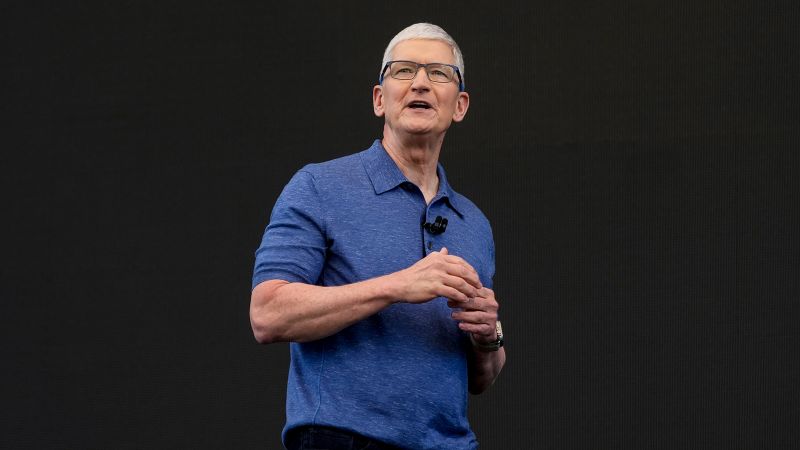Tim Cook, Apple’s CEO, recently announced on a quarterly earnings call that the technology powerhouse may incur an additional $900 million in costs this quarter due to current global tariff rates. This revelation comes as Apple shifts a significant portion of its iPhone production for the United States from China to India. This strategic change reflects Apple’s efforts to diversify its global supply chain in response to increasing tariffs imposed by the U.S. administration.
Cook articulated that the projected additional costs hinge on the assumption that existing tariff policies remain unchanged for the remainder of the quarter. He emphasized the potential financial impact by specifying, “Assuming the current global tariff rates, policies, and applications do not change… we estimate the impact to add $900 million to our costs.” This statement underscores the complex and often volatile nature of international trade relations and their direct implications for corporate finances.
Apple has gradually begun relocating some of its iPhone production to India over the past few years. Cook indicated that this transition is expected to escalate significantly, predicting that the majority of iPhones sold in the U.S. will soon have India listed as their country of origin. This migration of production is particularly significant given that nearly 90% of Apple’s iPhone manufacturing has historically remained rooted in China, despite ongoing efforts to establish diversified manufacturing processes elsewhere.
The announcement also highlights the broader implications of U.S. trade policy, particularly under the administration of former President Donald Trump, who implemented a staggering 145% tariff on products from China. As Cook noted, while certain exemptions for electronic devices have allowed for some relief, products manufactured in China still face a minimum 20% tariff, which directly impacts Apple’s pricing strategies and profit margins.
Following the earnings call, Apple’s stock experienced a nearly 4% decline in after-hours trading, a reflection of investor anxieties concerning ongoing tariff challenges and the potential instability within Apple’s supply chain. Cook addressed these concerns candidly, stating, “We have a complex supply chain. There’s always risk in the supply chain.” He further elaborated on the importance of diversification within their manufacturing processes, recognizing the risks associated with concentrating production in a single locale.
While many Apple products for markets outside of the U.S. will continue to be produced in China, Cook pointed out that Vietnam is poised to become the main manufacturing hub for nearly all iPads, Macs, Apple Watches, and AirPods intended for U.S. sales. This shift demonstrates Apple’s commitment to not only navigating current tariffs but also mitigating risks associated with geopolitical tensions.
Amid the tariff obstacles, Apple reported robust financial results for the January to March quarter, with revenues rising 5% year-over-year to $95.4 billion, surpassing analysts’ expectations. Specifically, iPhone revenue climbed 2% to $46.8 billion. Cook noted that their ability to optimize supply chain and inventory helped minimize the impact of tariffs in the recent quarter.
However, it is essential to highlight that Apple’s sales in the Greater China region, which includes Hong Kong and Taiwan, saw a slight downturn, registering $16 billion—a decrease of approximately 2% from the previous year. This decline can be attributed to intensified competition from domestic smartphone manufacturers in China, Apple’s second-largest market.
There are ongoing discussions within the U.S. government, particularly from the Trump administration, urging Apple to bring iPhone production back to American soil. Yet, analysts have labeled this ambition as nearly unattainable due to cost implications. Dan Ives, the global head of technology research at Wedbush Securities, warned that manufacturing iPhones in the U.S. could cause prices to soar to around $3,500, which would significantly alter market dynamics and consumer accessibility.
In light of this, Trump has often touted Apple’s $500 billion investment, announced in February, as a cornerstone of his administration’s economic record. Planned over four years, this investment is intended to expand production outside of China and mitigate the impact of tariffs. However, reports indicate that this financial commitment is primarily geared toward developing server facilities for Apple’s artificial intelligence service and constructing an academy for training in manufacturing techniques, rather than directly increasing iPhone production in the U.S.
In summary, Apple’s strategic move to shift production to India, while challenging, aims to reduce dependency on China amidst escalating tariffs and geopolitical tensions. Despite facing hurdles, Apple exhibits resilience through diversification of its supply chain, but continued scrutiny remains on its global operations and market performance.



